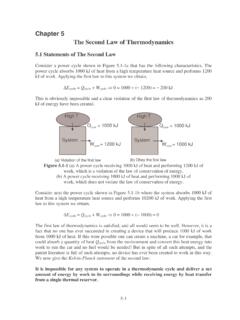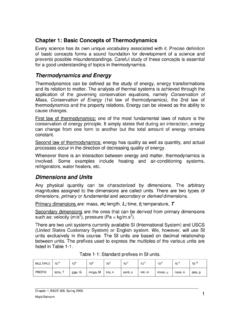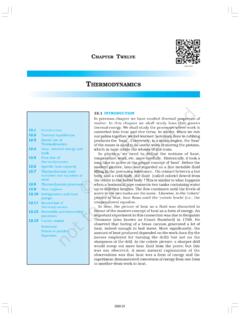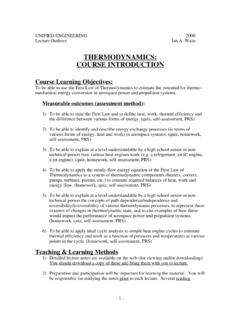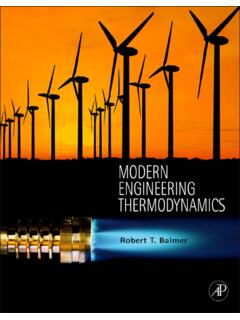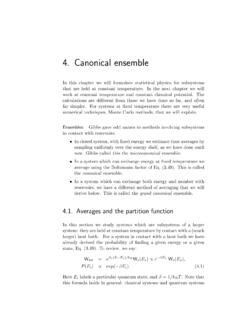Transcription of Chapter 2: Internal Energy (U), Work (w), Heat (q ...
1 Winter 2013 Chem 254: Introductory thermodynamics Chapter 2: Internal Energy , work , Heat and Enthalpy 13 Chapter 2: Internal Energy (U), work (w), Heat (q), Enthalpy (H) .. 13 Heat Capacities .. 16 Calculating U, H, w, q in Ideal Gas .. 18 Isothermal Compression .. 21 Reversible Process (limiting process) .. 22 Isothermal Expansion .. 22 Chapter 2: Internal Energy (U), work (w), Heat (q), Enthalpy (H) Internal Energy (excludes motion and rotation of vessel) Look at isolated part of universe systemEnvironmentU UU Total = isolated first law of thermodynamics : - Total U for isolated system is constant - Energy can be exchanged between various components - Energy forms can be interconverted Eg. Chemical En Heat work 0totalsystemenvironementUUU Winter 2013 Chem 254: Introductory thermodynamics Chapter 2: Internal Energy , work , Heat and Enthalpy 14 work In classical mechanics, move object a distance d with force F in direction of displacement is work N m = J F mg dh w mgh (kg m s-2 m = N m = J) cosw mgd coshd hw mgdmghd General formula wF dL Line integral PVwork (constant external pressure) m applies constant force FPA 12()()extFw mgh FhAhP V VA ()extfinalinitialwP VV Joules, or L Bar (1 L Bar = 100 J) Winter 2013 Chem 254: Introductory thermodynamics Chapter 2: Internal Energy , work , Heat and Enthalpy 15 More general formula for PV work , P does not need to be constant fiVextVwP dV Sign Convention.
2 work done on the system raises Internal Energy of system (0w ) work done by the system lowers the Internal Energy (0w ) Other forms of work : - electrical work wQ Q is charge in coulombs difference in potential (in Volts or J/C) Run a current over Q I t Iis current (in Amps or C/s) w I t Important: work is associated with a process, with change. work is transitory. You cannot say that a system contains that amount of Energy or heat Heat: associated with a process going from State 1 State 2 systemUq w qis heat; w is the work Heat is exchanged between system and environment 0q : system loses Energy 0q : system gains Energy systemenvironmentqq note: systemenvironmentTT for heat to flow Isolated system Winter 2013 Chem 254: Introductory thermodynamics Chapter 2: Internal Energy , work , Heat and Enthalpy 16 outerinnerTT (regulate) So there is no flow of heat 0systemenvironmentUU 0innerU Beaker + Lab +.
3 = environment (isolated) 0IU ; 0 IIU 0 IIIUU Chemical Energy 222 Butane + OCOH Note : 0 IIU even if temperature increases! Why? Chemical Energy of butane is converted to heat. Heat Capacities The amount of Energy (heat) required to raise the temperature of 1 gram of substance by 1 oC. Heat capacity of water is J/g K = 1 calorie 1) Heat capacity is dependent on heat Eg. 10 oC 11 oC and 80 oC 81 oC, require slightly different energies 2) At least 2 types of heat capacity a) Keep volume constant VC b) Keep pressure constant PC 3) Heat capacity is proportional to amount of substance Molar heat capacities : ,PmC ,,VmC n moles : ,VV mCnC , ,PP mCnC 4) General formula Winter 2013 Chem 254: Introductory thermodynamics Chapter 2: Internal Energy , work , Heat and Enthalpy 17 fiTVVTqC dT If VC is constant over temperature range: ffiiTTVVVVfiTTqCdT C TC TT ()VVqCT And ()PPqCT Which is larger PCor VC?
4 Relation for PCand VCfor ideal gas? 21VV ; 21TT 21()PPextU qw qP VV PVnRT 21()PU qnR TT PPqC T ; VVUqC T PVC T C T nR T PVCCnR or ,,P mV mCCR Therefore PC is larger than VC. At constant P, the system also does PV work when raising T. (analysis for ideal gas) No work because V is constant VUqw Vq VU C T Bomb calorimetry systemsurroundingCalorimeterVVVmeasureqq CT reactionU Winter 2013 Chem 254: Introductory thermodynamics Chapter 2: Internal Energy , work , Heat and Enthalpy 18 systemsurroundingsPVqq systemCalorimeterPVmeasureqCT systemPreactionqH True definition of Enthalpy ()HUPV 2 21 1 PVP VPV ; for 1 12 2 PVP V ; H U PV At constant Pressure 2 21 1 HUP VPV HU P V ()()PPH qw P VqP VP V PPHqC T Completely general :,UH are function of state specify ,,T V P 222111( , , )( , , )UU T P VU T P V 222111( , , )( , , )HH T P VH T P V Change in ,UH are the same for both paths Change in ,qw are different for different paths Calculating U, H, w, q in Ideal Gas 1) Calculating ,UH is easy if T is known ( )]ffiiTTVVTVfiTU U TUC dT C TC TT VU C T for any process ( ).
5 HH T Winter 2013 Chem 254: Introductory thermodynamics Chapter 2: Internal Energy , work , Heat and Enthalpy 19 PH C T for any process (if PC is constant) We know PVCCnR Special cases: Isothermal Process T is constant 0T ; 0UH 2) work : extwP dV PVwork only - Constant V 0ifVVw ; Vq qU - Constant Pext ()fiVextextfiVwPdVP VV ; Pq qH Isothermal reversible process: (Reversible process: delicate, see later) 1extPnRTV nRTis constant lnffiiVVVVdVwnRTnRTVV lnlnlnffiiVnRTVVnRTV lnfiVwnRTV 3) Heat Adiabatic process : 0q by definition Uq w ; Uw Adiabatic Reversible Process 0q , Uw , extnRTPV fiVVnRTUwdVV ,VmnRTnC dTdVV ,VmdTnRnCdVTV Winter 2013 Chem 254: Introductory thermodynamics Chapter 2: Internal Energy , work , Heat and Enthalpy 20 ,ffVmiidTdVnCnRTV ,lnlnffvmiiTVnCnRTV ,lnlnffvmiiTVCRTV For adiabatic reversible process: ,lnlnffvmiiTVCRTV OR ,lnlnfPmiifTCPRTP OR ,,lnlnfPmiiV mfVCPVCP 1) ,lnlnffvmiiTVCRTV ,,lnlnlnVmRCfffiV miiTVVRTCVV ,VmRCffiiTVTV 2) ,lnlnffvmiiTVCRTV ,lnlnffVmiifiTnRTCPRTPnRT lnfiifTPTP lnlnfiifTPTP ,1 lnlnfVmiifTCPRTP ,lnlnfVmiifTCRPRTP ,lnlnfPmiifTCPRTP Winter 2013 Chem 254: Introductory thermodynamics Chapter 2.
6 Internal Energy , work , Heat and Enthalpy 21 Adiabatic Isobaric Process Constant external pressure AND 0q Isothermal Compression Constant external pressure 0ffiwP VV 0qw (because 0U because isothermal) What is work in 2-step process? 2intintintiffwP VVP VV 21ww ; 21qq Winter 2013 Chem 254: Introductory thermodynamics Chapter 2: Internal Energy , work , Heat and Enthalpy 22 Conclusion: wand qdepend on details of process, not only on initial and final state. Repeat for 3 step, 54321wwwww ; 54321qqqqq The more steps, the less wand less heat Reversible Process (limiting process) extgasPP at each step extnRTPV Isothermal Reversible Process ffiiVVextVVdVwP dVnRTV ln |lnfiVfViVnRTnRTV work , qis minimal Isothermal Expansion Winter 2013 Chem 254: Introductory thermodynamics Chapter 2: Internal Energy , work , Heat and Enthalpy 23 10ffiwP VV ; 110qw 21ww ; 21qq 321www ; 321qqq More processes more work (w), more heat (q) 54321wwwww.
7 54321qqqqq Limiting Expansion work expl imitl imitcompressionansionww limitlnffiiVVfextVViVdVwP dVnRTnRTVV Winter 2013 Chem 254: Introductory thermodynamics Chapter 2: Internal Energy , work , Heat and Enthalpy 24 Grains of sand : I can run process either way The thermodynamic work is the same both ways for reversible process Irreversible Process (Big chunks of mass) Follows arrows in reverse: add mass, piston rises? ; removes mass, piston lowers? This is absurd, hence: Why do irreversible processes run in one way and not another? What is special about irreversible?


